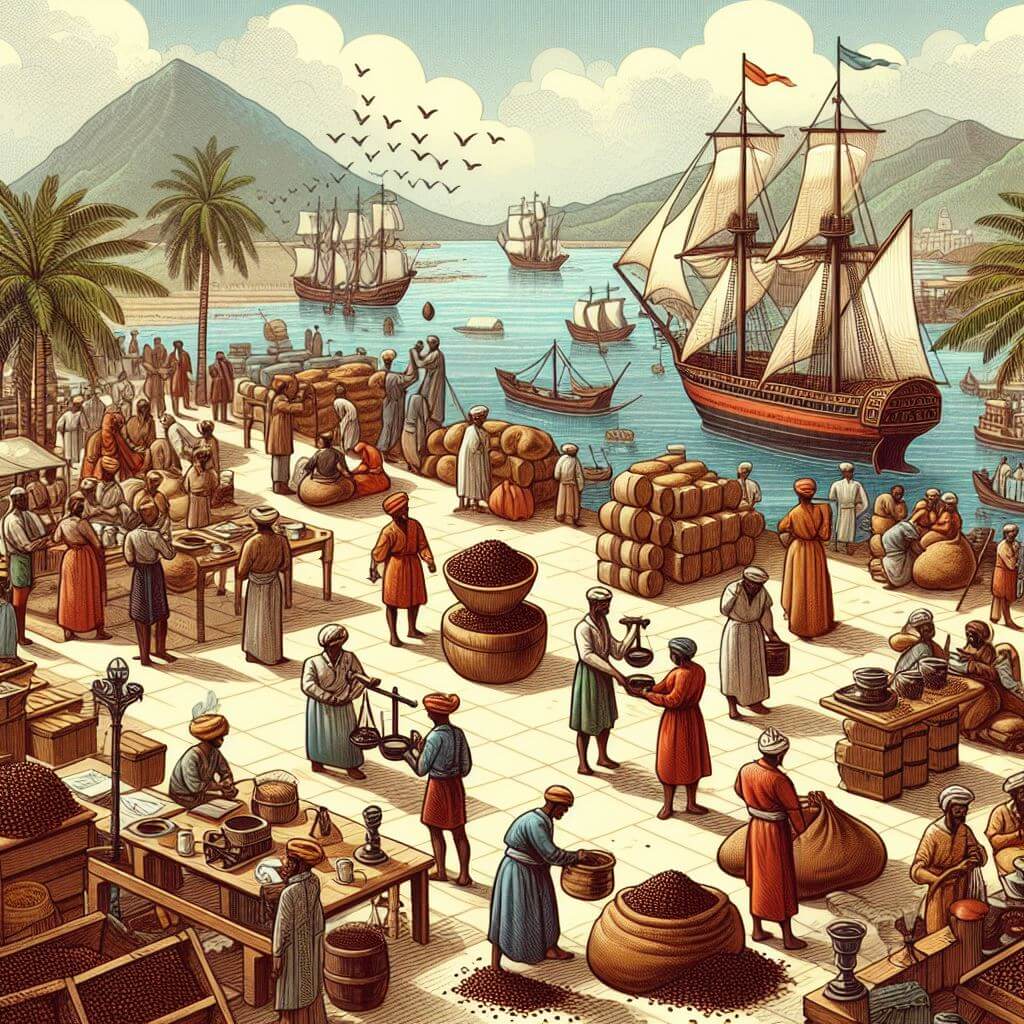
The global coffee market, an extensive and complex network that touches almost every corner of the globe, is a critical component of the global economic structure. At its core, the market consists of countries within the coffee belt, a geographic area encircling the Earth along the equator that has the ideal climate for growing coffee. Countries such as Brazil, Vietnam, Colombia, and Ethiopia not only account for most of the world’s coffee supply but also play a key role in shaping the dynamics of the coffee economy. Brazil, for example, is the world’s largest producer and exporter of coffee, a fact that greatly affects global coffee prices and availability.
The dynamics of trade in this market are complex and depend on many factors, including weather anomalies, political stability in producing countries, and changing global consumption patterns. For example, unexpected weather events such as frosts or droughts in key production areas can drastically reduce supply, causing global price spikes that affect the global economy. In addition, political instability in coffee-producing countries could disrupt supply chains, leading to further market volatility.
On the demand side, global consumption continues to grow steadily, driven by the growth of coffee culture in traditional tea-drinking countries and increased consumption in rapidly developing countries. As consumer preferences change, so does the desire for specialty and sustainably produced coffee, trends that are reshaping the market and opening up both opportunities and challenges for producers and retailers alike.
The volatility of coffee prices remains a significant problem. The coffee market is very susceptible to fluctuations caused by changes in supply and demand. These fluctuations can have far-reaching consequences for the economies of coffee-producing countries. Many of these countries rely on coffee as a major export commodity, and fluctuations in world market prices can significantly affect their economic stability. This volatility highlights the precarious nature of dependence on a single commodity, highlighting the need for diversified economic strategies and the development of sustainable coffee production methods to protect against market volatility.
Price volatility in the global coffee market underscores the importance of initiatives aimed at stabilizing prices and ensuring fair compensation for producers. To address these issues, mechanisms such as fair trade and direct trade have emerged to create a more equitable distribution of value in the coffee supply chain. As the global coffee market continues to grow, finding solutions to these economic challenges will be critical to ensuring the stability and health of the coffee industry as a whole, benefiting producers, consumers and the economies of coffee-growing countries worldwide.
Challenges In The Coffee Economy
Delving deeper into the challenges of the coffee economy, it becomes clear that the industry is grappling with issues that go far beyond market price volatility. A particularly acute problem is the glaring inequality that permeates the coffee supply chain. Despite coffee’s status as a lucrative global commodity, profits are unevenly distributed, often disproportionately favoring those further along the chain – such as international traders, roasters, and retailers – over the smallholder farmers who grow the crop. These farmers face numerous challenges, from fluctuating market prices that can suddenly drop below the cost of production to limited access to global markets. As a result, many coffee farmers find themselves mired in poverty and debt, a stark contrast to the billion-dollar industry their labor supports.
Another layer of complexity is added by the question of sustainability. Traditional coffee farming methods, especially those involving large sun-grown coffee plantations, have significant environmental impacts, including deforestation, soil erosion, and water pollution. These practices not only contribute to the broader climate change crisis but also threaten the long-term viability of coffee farming itself. As the climate changes and pests once controlled by natural cold cycles become more common, coffee production becomes more risky. This environmental challenge is interconnected with economic sustainability; without a shift to more sustainable practices, the future of coffee—both as a beverage of choice and as a source of livelihood for millions—will be in jeopardy.
The transition to more sustainable farming practices comes with its own set of challenges. Such practices often require upfront investment that is beyond the reach of small farmers. Furthermore, while sustainable certificates can open the door to premium markets, obtaining and maintaining such certificates is often an expensive and complex process.
In addressing these multifaceted challenges, it is important to recognize the interdependence of environmental sustainability and economic equity. Efforts to improve the economic well-being of coffee farmers must go hand in hand with the promotion of sustainable agricultural practices. Only through such an integrated approach can the coffee economy move towards a model that is both environmentally sustainable and economically just. This involves not only an adjustment within the coffee industry but also a wider change in consumer awareness and behavior, recognizing the true value and worth of coffee, enjoyed by millions of people around the world.
On The Way To A Stable And Fair Coffee Trade
To steer the coffee trade towards a future that is both sustainable and fair, a multifaceted approach involving all stakeholders – from coffee producers and industry players to consumers and policymakers – becomes essential. The journey to this future is based on promoting equity and sustainability at every stage of the coffee supply chain, a challenge that requires innovative solutions and collaborative efforts.
A cornerstone of these efforts is the promotion of fair trade practices. By ensuring that coffee farmers receive a fair share of the profits, Fair Trade aims to alleviate poverty and improve living conditions in farming communities. However, this approach goes beyond simple financial compensation. Fairtrade also includes supporting sustainable farming practices, promoting environmental conservation efforts, and the long-term viability of coffee farming. At the same time, fair trade products often command a high price, which is a direct investment in ethical farming practices and fair wages. Encouraging consumers to choose fair-trade coffee is an important part of developing a fairer industry.
In addition to fair trade, technological innovation is a key ally in the quest for a sustainable future for coffee. Advances in agricultural technology, such as precision farming tools and environmentally friendly pest control methods, can increase yields and quality while reducing environmental impact. At the same time, such innovations have the potential to make sustainable practices more accessible to smallholder farmers by reducing the cost and complexity of implementation.
Increasing transparency and traceability in the coffee supply chain is equally important. As more informed consumers demand to know the origin of their coffee and the conditions in which it was produced, there is a growing incentive for industry players to adopt more transparent practices. This better visibility can help ensure that the benefits of the coffee trade are more evenly distributed and that sustainable practices are followed throughout the supply chain.
Building stronger partnerships is another vital step towards a sustainable and fair trade in coffee. This involves facilitating cooperation between farmers, exporters, roasters, retailers, and even consumers. Thanks to such cooperation, it becomes possible to develop common goals and strategies for sustainable coffee production and trade. It also opens up opportunities for more direct trade models that can further increase the share of profits returned to coffee producers.

